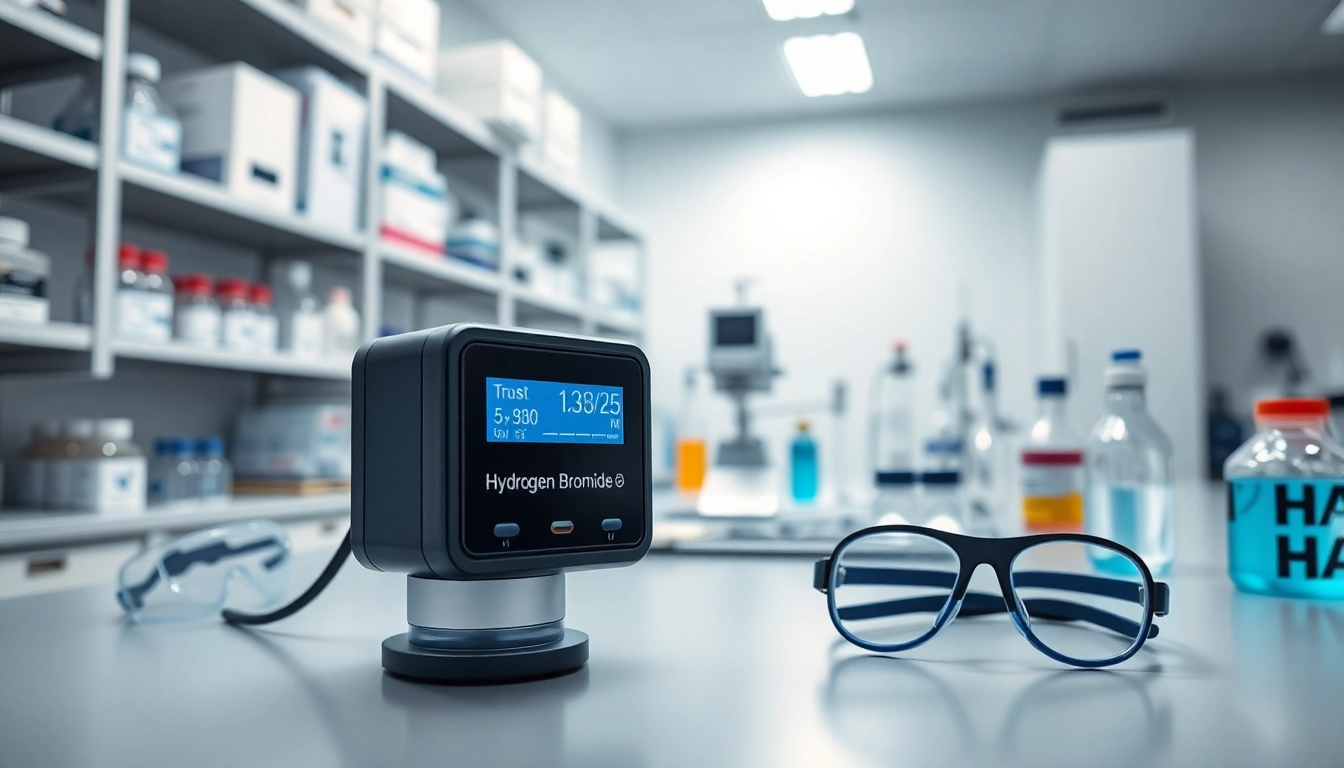
Understanding Hydrogen Bromide: Properties and Risks
What is Hydrogen Bromide?
Hydrogen Bromide (HBr) is a colorless gas at room temperature that exhibits a pungent and acrid odor. It is highly soluble in water, forming hydrobromic acid upon dissolution. Hydrogen bromide is classified as a strong acid and is a crucial reagent in various chemical processes, particularly in the production of brominated compounds. Its chemical formula consists of one hydrogen atom and one bromine atom, rendering it a significant substance in organic chemistry.
Health and Safety Risks of Hydrogen Bromide Exposure
Exposure to hydrogen bromide can pose serious health risks, particularly due to its corrosive nature and potential to cause severe respiratory issues and skin irritation. Inhalation of hydrogen bromide vapors can lead to coughing, choking, and inflammation of the respiratory tract. Prolonged exposure can result in damage to lung tissues, leading to complications such as pulmonary edema.
On physical contact, hydrogen bromide can cause severe burns and irritation of the skin and eyes. The Occupational Safety and Health Administration (OSHA) has set permissible exposure limits (PEL) for hydrogen bromide at 3 ppm over an 8-hour period, emphasizing the importance of monitoring levels in industrial environments. Implementing effective Hydrogen Bromide detection methods is crucial for maintaining safety.
Common Industries Using Hydrogen Bromide
Hydrogen bromide finds utility in several industries, including:
- Chemical Manufacturing: Used in the production of brominated compounds and as a reagent in various chemical reactions.
- Pharmaceuticals: Involvement in synthesizing active pharmaceutical ingredients (APIs).
- Petrochemicals: Assists in alkylation processes and the production of anti-knock agents.
- Research and Development: Commonly utilized in laboratories for analytical purposes and chemical syntheses.
- Agriculture: Utilized in the formulation of pesticides and other agrochemicals.
Hydrogen Bromide Detection Methods
Overview of Detection Technologies
Detecting hydrogen bromide is essential for ensuring workplace safety and compliance with regulations. Various technologies are available, each with its benefits and limitations. The most common detection methods include:
- Infrared Spectroscopy: This method uses infrared light absorption to identify HBr concentrations. It is highly sensitive and capable of detecting low levels of hydrogen bromide.
- Electrochemical Sensors: These sensors measure changes in electrical current when HBr reacts with an electrode. They are compact and suitable for continuous monitoring.
- Gas Chromatography: A highly accurate method for analyzing gas mixtures, gas chromatography can identify and quantify hydrogen bromide levels but requires more complex setups.
- Colorimetric Detection: This method relies on chemical reactions that produce a color change in the presence of hydrogen bromide. It provides a quick and visual indication but may not provide precise measurements.
Choosing the Right Detection Equipment
Selecting appropriate detection equipment for hydrogen bromide depends on several factors:
- Detection Range: Determine the expected concentration levels of hydrogen bromide in the environment. Different sensors have varying ranges and sensitivities.
- Response Time: Look for equipment that provides rapid responses to changes in HBr levels to enable timely preventive actions.
- Environmental Conditions: Consider the operating conditions (temperature, humidity, and presence of other gases) that may impact detection accuracy.
- Maintenance Requirements: Evaluate the calibration frequency and general maintenance needs of the detection equipment.
Calibration and Maintenance Best Practices
Regular calibration and maintenance of hydrogen bromide detection equipment are critical for ensuring accuracy and reliability. Best practices include:
- Routine Calibration: Conduct periodic calibration using known standards to ensure detection accuracy.
- Inspection and Cleaning: Regularly inspect the sensors and clean them to remove contaminants that could affect performance.
- Documentation: Maintain records of calibration and maintenance activities for compliance and tracking purposes.
- Training Personnel: Ensure that employees are trained to understand the equipment’s functioning and maintenance protocols.
Implementing Effective Detection Systems
Factors to Consider When Designing Detection Systems
When designing detection systems for hydrogen bromide, several critical factors should be considered:
- Location of Sensors: Place sensors in areas where hydrogen bromide is most likely to accumulate, such as near storage tanks or production areas.
- Integration into Existing Systems: Ensure compatibility with existing safety and monitoring systems for seamless operation.
- Alarm Systems: Implement reliable alarm systems that can alert personnel to hazardous levels of HBr.
- Redundancy: Incorporate backup systems to ensure detection capabilities are maintained in case of equipment failure.
Integrating Detection into Existing Safety Protocols
Hydrogen bromide detection systems should be integrated into the broader safety protocols of an organization. This integration can improve emergency response, training, and overall safety culture:
- Regular Training: Conduct regular training sessions for all employees on the use of detection equipment and emergency protocols related to hydrogen bromide exposure.
- Emergency Response Plans: Develop clear emergency response plans that incorporate real-time data from hydrogen bromide detection systems.
- Data Sharing: Ensure data from detection systems is shared among stakeholders to facilitate informed decision-making regarding safety measures.
Case Studies: Successful Implementations
Several organizations have successfully implemented hydrogen bromide detection systems, leading to enhanced safety outcomes. Notable examples include:
- Manufacturing Plant: A chemical manufacturing facility integrated electrochemical sensors across key production areas, reducing incident response time by 50% and improving overall workplace safety.
- Research Laboratory: A leading research lab adopted an infrared detection system that enabled real-time monitoring, resulting in a significant decrease in exposure incidents.
Monitoring and Reporting Hydrogen Bromide Levels
Data Collection Techniques and Software Solutions
Monitoring hydrogen bromide levels requires robust data collection techniques and software solutions. Effective approaches include:
- Automated Data Logging: Utilize software that automatically logs data from detection systems for continuous monitoring and reporting.
- Remote Monitoring: Implement remote monitoring solutions that allow real-time data access from multiple locations.
- Integration with Safety Systems: Combine monitoring software with existing safety management systems for comprehensive oversight.
Establishing Reporting Protocols
Establishing clear reporting protocols ensures that critical information regarding hydrogen bromide levels is communicated effectively:
- Regular Reporting: Define the frequency of reporting hydrogen bromide levels to appropriate personnel and regulatory bodies.
- Incident Reports: Develop templates for documenting any incidents involving hydrogen bromide exposure, emphasizing lessons learned for prevention.
- Data Visualization: Utilize data visualization tools to present hydrogen bromide trends and alerts clearly and understandably.
Utilizing Data to Improve Safety Measures
Data collected from hydrogen bromide monitoring systems can significantly enhance safety measures through:
- Trend Analysis: Regular analysis of monitoring data can identify trends that indicate potential risks and help plan preventive measures.
- Auditing and Compliance: Use monitoring data to assist in compliance audits and to demonstrate adherence to safety regulations.
- Performance Metrics: Establish key performance indicators (KPIs) to evaluate the effectiveness of detection systems and safety protocols.
Future Trends in Hydrogen Bromide Detection
Innovations in Detection Technologies
The field of hydrogen bromide detection is evolving rapidly, with innovations being introduced regularly. Emerging technologies include:
- Miniaturization of Sensors: Advances in nanotechnology are leading to the development of smaller, more sensitive hydrogen bromide sensors that can be deployed in greater numbers, providing more comprehensive coverage.
- Wireless Technologies: Adoption of wireless communication allows for easier installation and flexibility in monitoring systems without extensive wiring.
- Artificial Intelligence: AI algorithms may be integrated into monitoring systems to predict exposure levels based on environmental conditions and past incidents.
Regulatory Changes Impacting Detection Practices
As regulations surrounding safety and environmental protection become stricter, organizations must stay informed about the evolving legislative landscape. Key considerations include:
- Updates to PELs: Monitoring changes to permissible exposure limits for hydrogen bromide and adjusting detection systems accordingly.
- Environmental Regulations: Compliance with environmental regulations that require monitoring of hazardous substances in industrial effluents.
Preparing for the Future of Workplace Safety
Organizations must proactively prepare for the future by investing in safety training and advanced detection systems. Strategies include:
- Continuous Training and Education: Foster a culture of safety by investing in regular training programs for all employees.
- Developing Resilience Plans: Construct resilience plans that adapt to emerging risks and ensure effective responses to HBr-related incidents.
- Collaboration with Experts: Partner with safety specialists and regulatory agencies to ensure alignment with best practices and technological advancements.







